Drop-shot upshot
Tips and tactics to improve efficiency and effectiveness of underwater rigging
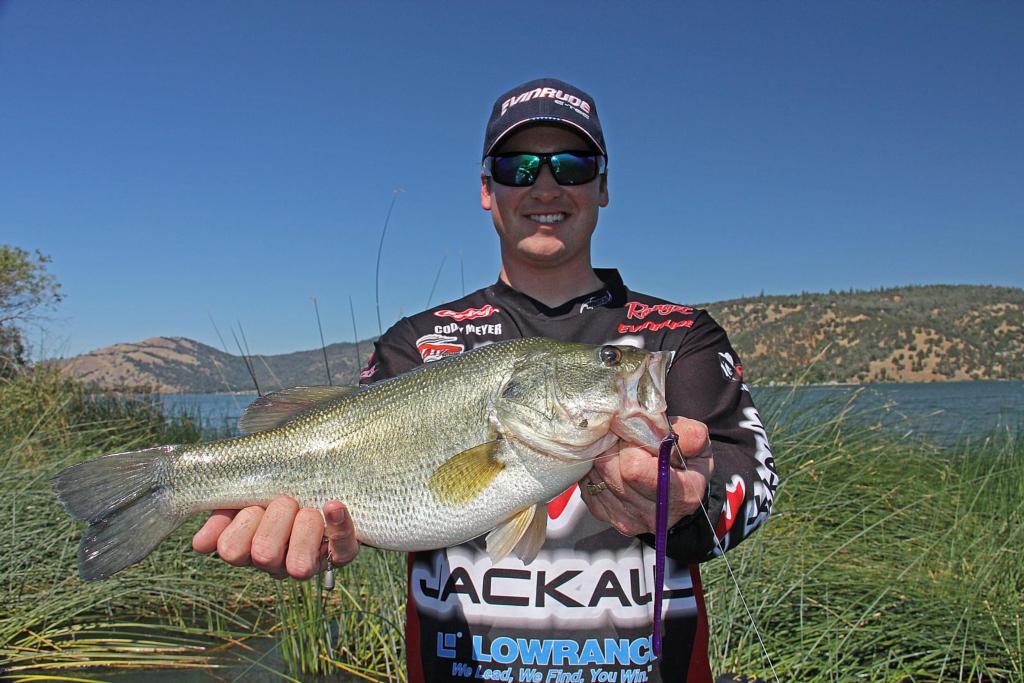
When bass play hard to get – either with deep inhabitance or bad attitudes – the drop-shot proves its merit as a bona fide tough-bite negotiator. This effective finesse tactic consistently appeals to green and brown fish coast-to-coast, but a handful of tips for tweaking your rig and perfecting your presentation will make a significant difference in your productivity.
Let’s start with fish location. Drop-shot scenarios are countless, but these principles bear broad applicability.
When graphing fish, some are okay with just “video gaming” their way to a few drop-shot bites, but savvy anglers know that a little closer look, a little more analysis, a little more targeted presentation can yield a big payoff. That was the deal for Ontario pro Bob Izumi, who notched his first U.S. win at the EverStart Series Northern Division event at the 1000 Islands. Scouring breaklines in 24 to 40 feet, Izumi found his best action over small hooks in the bottom – especially those with bait pods near. Taking the search a step further, Izumi suggests snooping around the initial find to locate heftier targets.
“Those bigger fish sometimes tend to be off the edges,” he said. “What I find is that if you’re getting numbers around 24 feet of water, drop down into the 30- to 32-foot range or even deeper because those bigger fish tend to sit off the big schools.”
Similarly, when working large rock piles, modern side-viewing sonar will show you those sneaky little “satellite” rocks where big fish often hold. And where the bottom plunges into a vast abyss, the last piece of structure before the drop can be drop-shot gold. Just ask Lawrence Mazur, who drop-shotted his way to the EverStart Series Northern Division win on Lake Erie.
Mazur fished Poor Boys Erie Darters over chunk rock and boulders in 52 to 70 feet. As the last area of structure before the bottom rolled into 130 feet of water, this hard stuff offered solace for bait schools that weren’t keen on roaming open bottom. Smallies loved the deep, cool environment with a replenishing buffet. Probing the rocks with Poor Boys Erie Darters was a slam dunk.
 For shallow environs with emergent vegetation, California pro Matt Newman said drop-shotters are wise to monitor the sun’s progression – specifically its effects on shifting shadow lines and the dark pockets they create. California pro Matt Newman looks for “shadow pockets” along the edges of tule islands and berms throughout the Cal Delta and Clear Lake. Bass seeking solace from sunlight are suckers for a well-placed dropshot, but noting that these pockets will shift throughout the day, Newman moves with the changing light.
For shallow environs with emergent vegetation, California pro Matt Newman said drop-shotters are wise to monitor the sun’s progression – specifically its effects on shifting shadow lines and the dark pockets they create. California pro Matt Newman looks for “shadow pockets” along the edges of tule islands and berms throughout the Cal Delta and Clear Lake. Bass seeking solace from sunlight are suckers for a well-placed dropshot, but noting that these pockets will shift throughout the day, Newman moves with the changing light.
“In the morning, you may find a (consistent) bite along one side of the tules but in the afternoon, those areas will slow down because the shadows have shifted,” Newman said. “Fish the other side of tule islands and you’ll often find that the fish have (relocated) to the new shadow pockets.”
Differentiate offerings
As with any presentation, bass can grow accustomed to seeing too much of the same drop-shot baits. Fishing a wacky-rigged bait can certainly enhance your drop-shot’s appeal, but turning a worm sideways isn’t the only option. Sometimes, a departure from skinny plastic sticks or small minnow shapes will tempt your quarry.
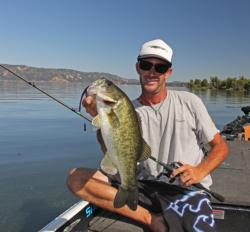 Power-shotting with oversized drop-shot rigs and worms like those you might Texas rig is a common thought here, but Newman likes to beef up his lighter presentations with larger profile baits. In areas where bass see a lot of Robo worms, he’ll rig a 3-inch Wave Little Dude craw or even a 4-inch Platypus. From tules, to reeds to any other stalky vegetation, such baits resemble the mudbugs that often cling to this habitat. Moreover, while slender worms can be tougher to spot against such environments, bass aren’t likely to overlook the larger profile of a craw or creature bait.
Power-shotting with oversized drop-shot rigs and worms like those you might Texas rig is a common thought here, but Newman likes to beef up his lighter presentations with larger profile baits. In areas where bass see a lot of Robo worms, he’ll rig a 3-inch Wave Little Dude craw or even a 4-inch Platypus. From tules, to reeds to any other stalky vegetation, such baits resemble the mudbugs that often cling to this habitat. Moreover, while slender worms can be tougher to spot against such environments, bass aren’t likely to overlook the larger profile of a craw or creature bait.
Pushing the envelope of creative thinking, Alabama angler Gil Johnson has developed a hybrid drop-shot tactic he calls “frog-shotting.” Employing this rig mostly for targeting fish suspended off the bottom, Johnson hangs a Snagproof Bobby’s Perfect Frog or Bleedin’ Frog on an 8-inch dropper loop to allow sufficient room for a bass to gulp the bait without bumping the line, and anchors the deal with about a ¼-ounce weight.
“I’m not afraid to try this anytime, but when I use this rig the most is in cold weather when the fish are backing off the bank and suspending,” Johnson said. “It’s just showing the fish something different; they see so much of the same stuff.”
Sensory stimulation
Even with more traditional drop-shot bait shapes, anglers can coax a response by making their plastic look, smell and taste more appealing. When drop-shotting Senkos – either nose hooking the 3-inchers or wacky rigging the bigger sticks – Florida pro Matt Greenblatt enhances his bait’s appearance by rubbing the plastic to alter its color.
For more specific cosmetics, permanent markers can open up a palate of creativity for drop-shotters seeking to stimulate stubborn bass. Gills, fins, stripes and dots – accents of subtle or overt degree can make a bait stand out from the parade of plastics marching through heavily pressured waters.
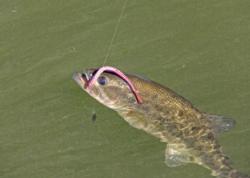 Also worth consideration is the influence of ultraviolet rays, which comprise the majority of subsurface light, especially in deep and/or stirred water. Lacking the UV filters that protect human eyes, bass can see ultraviolet light reflecting off their prey and this helps them target food in low-light conditions. TightlinesUV Lure Company makes soft plastics – including a 4-inch finesse worm – with a patented Nano-Infused Polymerization (NIP) technology that reflects UV light. Additionally, products like Sisson’s Secret Sauce and UV Blast (OS Coatings) enable anglers to add a UV reflective coating to any soft plastics.
Also worth consideration is the influence of ultraviolet rays, which comprise the majority of subsurface light, especially in deep and/or stirred water. Lacking the UV filters that protect human eyes, bass can see ultraviolet light reflecting off their prey and this helps them target food in low-light conditions. TightlinesUV Lure Company makes soft plastics – including a 4-inch finesse worm – with a patented Nano-Infused Polymerization (NIP) technology that reflects UV light. Additionally, products like Sisson’s Secret Sauce and UV Blast (OS Coatings) enable anglers to add a UV reflective coating to any soft plastics.
Scent matters too. Bass are primarily sight feeders, but unless they have a cold, they’ll pay more attention to something that not only smells edible, but equally important – something that does not smell like human hands. Pennsylvania pro Charlie Hartley said his bait scenting effort is as much about masking his smell as it is about enhancing the plastic.
New Hampshire’s Joe Lucarelli often dips his drop-shot baits in JJ’s Magic garlic oil, but because of the rig’s orientation, he dips the heads, rather than the tails. “I want the fish to bite the head because that’s where the hook is,” he said.
Lucarelli said the jar of peanut butter he carries is mostly for midday sandwich making, but the protein-packed spread also comes in handy when all that garlic dipping leaves an intolerable scent on his fingers. Smearing a generous dollop of peanut butter on his hands, giving them a thorough scrub and rinsing in the lake is an instant scent remover.
Berkley GULP! baits have cemented an indelible position on the drop-shotting landscape, as the scent and taste enhancing formula practically eliminates nibbling in this inherently subtle tactic. Gulp! and Gulp! Alive baits must remain moist lest they shrivel, but during a hot bite, fiddling with zippered bags containing one of the foulest liquids known to man can quickly lead to messy, clothes-soiling spills of the marriage-ending kind. Prevent mishaps by combining a day’s worth of different shapes and colors, along with their accompanying scented liquids in a sealable food container or one of the plastic buckets in which larger Gulp! Alive quantities are sold.
Drop and deliver
When it comes to drop-shot rigging, western pro Cody Meyer stresses the importance of keeping the bait as perfectly perpendicular as possible. Connecting his hook with a Palomar knot, Meyer insists on passing the tag end back through the eye after cinching the knot to ensure that his leader hangs straight. Daiichi’s Standout hook also helps achieve the right drop-shot form with an extra arm that bends below the line tie, somewhat like a 7, with the actual eye at the end of this arm. Tie a Palomar to the line tie and then pass the tag end through the hook’s eye to maintain a right angle posture.
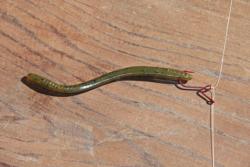 Another option, the VMC Spinshot, fits a drop-shot hook on a light wire stem with line ties at both ends. Tying the main line to one end and the leader to the other keeps the hook properly positioned and allows 360-degree mobility without twisting line on the drop.
Another option, the VMC Spinshot, fits a drop-shot hook on a light wire stem with line ties at both ends. Tying the main line to one end and the leader to the other keeps the hook properly positioned and allows 360-degree mobility without twisting line on the drop.
As for weight selection, shallow and/or clear water necessitates the lightest weight you can use to still maintain bottom contact. However, when wind, waves and current make for a bouncy ride in deep water, Izumi says bigger is better. He and his Great Lakes brethren won’t hesitate to rig 1-ounce drop-shot weights if that’s what it takes to keep their bait on target.
“I want a weight that will get down there quickly when I mark fish on my graph,” Izumi said. “It’s important to drop on them and not have a light weight that slowly falls. You want something that’ll get down there and almost hit them on the head.”
Mazur won the Erie event with a three-day total of 64 pounds, 8 ounces – a pretty strong average for brown fish. He was on a huge pile of smallies, but while some might say that this type of fishing is simply the luck of the draw, Mazur believes that anglers have more influence than they realize over which fish bites their drop-shot. The key, he said, may sound counterintuitive, but you actually want to minimize the attention you attract. Bottom line: When you find the meat pile, it’s better to wait on quality than wade through quantity.
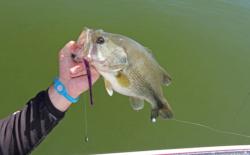 “Everybody likes to take the drop-shot and shake it, but it doesn’t need to be shaken,” he said. “People start shaking the rod tip 12 inches and who knows what that thing’s doing down there? It’s bouncing all over the place and, of course, the little fish are like `I got it, I got it. I’ll eat it.’ So you’re attracting little fish. You want that subtle action down there so a big fish sees it and sucks it in because he doesn’t want anybody else to see that he (ate) it.”
“Everybody likes to take the drop-shot and shake it, but it doesn’t need to be shaken,” he said. “People start shaking the rod tip 12 inches and who knows what that thing’s doing down there? It’s bouncing all over the place and, of course, the little fish are like `I got it, I got it. I’ll eat it.’ So you’re attracting little fish. You want that subtle action down there so a big fish sees it and sucks it in because he doesn’t want anybody else to see that he (ate) it.”
Even between fishing spots, it’s wise to control a drop-shot’s action, as a loose leader and weight can tangle with adjacent baits and chip rods during boat rides. Unlike a crankbait, jig or Texas-rigged lizard, a drop-shot is not so easily restrained between uses. Secure the hook and you still have a dangling weight to consider. Solve this problem by wrapping rubber bands around the rod butt for simple leader tamers. Just tuck the weight under its tether and keep your rig neatly controlled until the next drop site.